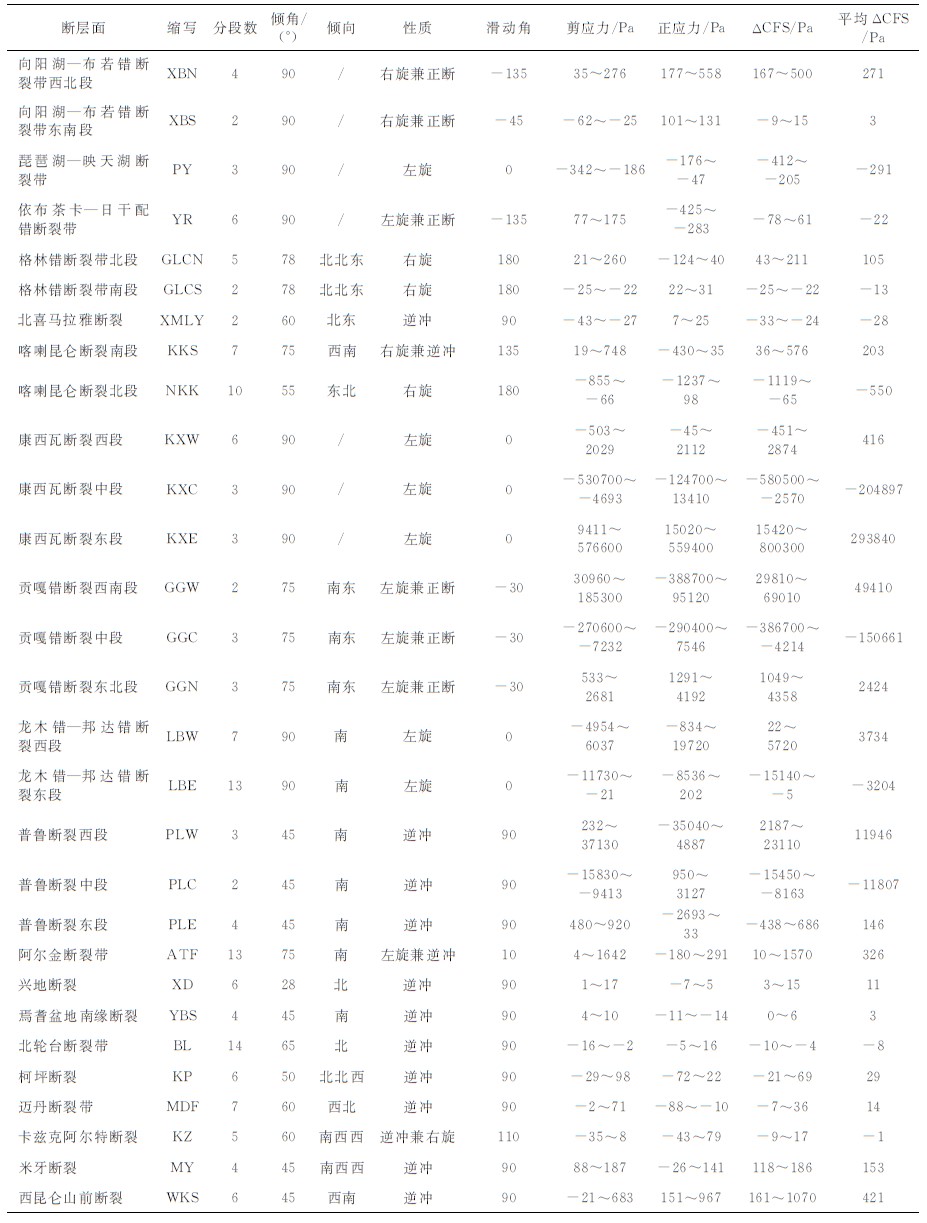2. 北京大学地球与空间科学学院地球物理系, 北京 100871;
3. 中国地震局地球物理研究所, 北京 100081
2. Department of Geophysics, School of Earth and Space Science, Peking University, Beijing 100871, China;
3. Institute of Geophysics, China Earthquake Administration, Beijing 100081, China
2008年3月21日当地时间06时33分,新疆于田县发生7.3级地震.该地震发生在和田东南~130km、于田南~110km处,处于西昆仑造山带内.震中位于海拔高度约为5500 m的无人区,但造成于田县多处民房倒塌.该地震发生在距印度板块和欧亚板块碰撞带数百公里的青藏高原北缘,位于东北向的阿尔金断裂和东西向的普鲁断裂之间,地质构造较为复杂(图 1).印度板块相对于欧亚板块以约46mm/a的速度向北运动,北向压缩使得青藏高原内部产生南北向的缩短和东西向的拉张.该地震可能反映了南部以喜玛拉雅山和主逆冲边界为界,北部以塔里木盆地为界的横跨青藏高原消减区的大尺度效应.青藏高原的东西向扩张导致了相对于欧亚板块北部的青藏高原东向运动,造成了与高原内部大尺度阿尔金断裂和昆仑断裂左旋走滑相适应的构造运动.因此深入研究该地震及其对周围断层的影响对于理解青藏高原的动力学模型乃至青藏高原内部的地震危险性分析均具有重要的意义.
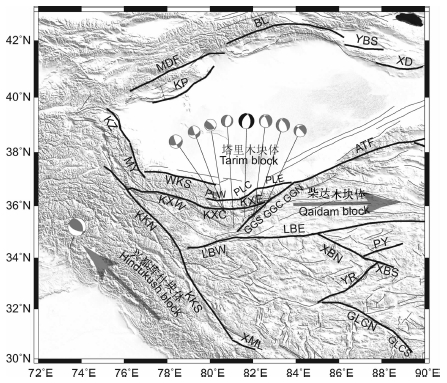
|
图 1 地震位置及周围断层分布.粗线为本研究的主要活动断层[16],细线为研究区域的所有断层.黑色海滩球为于田地震震源机制解,其周围的灰色海滩球为1976年以来发生的地震震源机制解,均为正断层机制.喀喇昆仑以西的灰色海滩球为2005年巴基斯坦地震的震源机制.图中的箭头示意给出兴都库什块体和柴达木块体相对塔里木块体的运动方向.断层名的缩写列于表 1. Fig. 1 Epicenter location and regional fault map. Thick lines are the major active faults investigated in this study, and thin lines are all the faults in the region. A black beach ball shows the focal mechanism of the Yutian earthquake, and the gray beach balls surrounding it are the focal mechanisms of earthquakes occurred since 1976. All of the events are normal faulting. A gray beach ball west of Karakoram fault marks the 2005 Pakistan earthquake. The vectors show the block motion directions of the Hindukush and Qaidam blocks relative to the Tarim block. Abbreviations of fault names are listed in Table 1. |
|
|
表 1 本研究所用的地质断层参数及正应力、剪应力和库伦破裂应力变化 Table 1 Fault segment parameters and their calculated normal stress, shear stress and Coulomb failure stress changes |
近年来,国际地震界广泛关注大地震产生的库仑破裂应力变化对后续地震发生位置和时间的影响[1, 2].在中国,早在20世纪80年代初,王仁等[3]就模拟了华北地区七百年来的应力演化过程,给出了该地区的地震危险性分布.Stein和Lisowski[4]对1979年Homestead Valley地震序列进行研究,发现余震丛集发生在应力增加区.万永革等[5]研究了中国大陆4个大地震对后续破裂事件的影响,发现前面发生的事件对后续事件均有触发作用.万永革等[6~8]采用Harvard矩心矩张量目录在统计上进一步验证了前面大地震对后续大地震的影响.沈正康等[9, 10]采用黏弹性地球模型分别研究了东昆仑和华北地区的大震之间的应力相互作用关系,发现大部分前面发生的地震对后续大地震和余震有触发关系.Robinson和Zhou[11]考虑了周围发震断层的形状研究了唐山地震初始破裂断层产生应力对后续断层破裂的影响,并研究了唐山地震发生后对后续大余震的影响,发现如果已知周围的断层滑动习性,可以用来预测将来大余震发生的地点.Lienkaemper[12]等研究了1989年Loma Prieta地震及深部蠕滑对已知滑动特性的Hayward断层的响应.McCloskey et al.[13]计算了2004年苏门答腊大地震产生的库伦破裂应力变化,指出消减带的Nias-Simeulue段上库伦破裂应力显著增加,3个月后,一个Mw8.7的地震就发生在该段上.汶川地震发生后,Parsons等[14]、万永革等[15]迅速根据地震周围的断层参数给出了汶川地震对周围断层活动的影响.本文根据前人得到的于田地震周围的断层几何形状和滑动习性[16],研究该地震在周围断层上产生的库仑破裂应力变化,从而判断于田地震对周围断层上地震活动性的影响.
2 计算方法地震是由地下的岩石错动产生的,在地震之后比较短的时间内,弹性能的释放是主要的物理过程,此时作为一级近似,可以把地球介质简化为半无限空间内均匀各向同性完全弹性体,如果已知地震位错面的几何参数和错动量,则可求出在弹性体内部产生的位移场和应变场.对此已有了严格的计算[17~19].在此,我们用Okada[19]给出的适用于各种类型断层的解析表达式计算地震产生的静态应力应变场.运用库仑准则,断层面上的库仑破裂应力变化为

|
(1) |
式中,Δτs为剪切应力变化,Δσn为法向应力变化(拉伸为正),μ为内摩擦系数,Δp为孔隙压力变化[20, 21].孔隙压力减少摩擦系数的效应可用μ′=μ(1-B)表示,其中B为Skempton系数,范围为0~1 [22].因此,式(1)变为

|
(2) |
在我们的计算中,参照Stein等[20]和King等[21]的做法,采用μ′=0.4,我们也给出μ′=0.0,0.8的情况,以观察正应力对计算结果的影响.我们将剪切应力变化投影到假定的滑动方向,与假定的滑动方向一致取正,反之取负.假定的滑动方向取自后续破裂事件的震源机制.
3 地震及其周围断层参数的选取 3.1 地震参数中国地震台网中心提供的地震震中位置为81.6°E,35.6°N.哈佛大学给出的震源位置为81.38°E,35.54°N,深度12km,矩震级为7.1,主张应力轴走向和倾伏角为北偏西70°和1°,主压应力轴的走向和倾伏角分别为南偏西8°和73°.两个节面的走向、倾角和滑动角为354°、47°、-113°和206°、48°、-67°,地震矩为5.52×1019 N·m.根据NEIC(National Earthquake Information Center)的初步矩张量测定结果,该地震的地震矩为8.3×1019 N·m,震源深度为22.9km(ftp://hazards.cr.usgs.gov/maps/sigeqs/20080320/ 20080320.pdf),主张应力轴为北偏西67°,倾伏角为21°,主压应力轴为南偏东21°,倾伏角为60°,为正断层型地震,如图 1所示.图中海滩球的黑色区域为膨胀区,白色区域为压缩区.确定的两个节面的走向、倾角、滑动角分别为353°、29°、-131°和219°、69°、-68°.虽然哈佛矩张量目录和NEIC给出的地震矩张量在数值上有一定的差别,但机制均为正断层机制.考虑到1997年发生在此地震以东约500km的玛尼地震的破裂深度只有8km[23],2001年发生在此地震以东约800km的昆仑山口西地震的破裂也集中在10km以上的浅部[24~27];综合分析这些因素,哈佛大学给出的矩心矩张量目录的参数可能较为准确,本研究采用该地震目录的地震矩张量参数;而中国数字地震台网使用了较近台站的数据,震源位置应该最准确,为本研究所采用.本次地震发生后尚未作过震中区野外科考,具体发震断层破裂尺度未有观测数据.我们根据以上地震参数采用Wells和Coppersmith[27]给出的地震断层长度、滑动量的统计公式估计断层长度为57.5km,滑动量为188cm,根据地震矩得到的断层宽度为25.6km.根据这些参数,计算地震产生投影到给定断层面和滑动方向上的库仑破裂应力变化.
3.2 接收断层参数邓起东等[16]搜集了中国大陆主要活动断裂数据,并对其进行了分析,得到了中国大陆活动构造基本特征.沈正康等[28]指出中国大陆形变数据可以由这些活断层数据来解释,进一步验证了该断层数据集的可靠性.我们挑选新疆于田地震周围第四纪较为活动的断层数据进行简化,研究于田地震在这些活动断层8km深度上产生的库仑破裂应力变化(表 1).
4 结果断层破裂的主要驱动力为加在断层面上的剪切应力.正应力根据视摩擦系数不同而影响库伦破裂应力变化.为了表示正应力和剪切应力在计算库伦破裂应力变化中的贡献,我们将8km处的剪切应力变化和正应力变化分别表示在图 2a和图 3a,并列于表 1.剪切应力变化也是μ′=0.0的库伦破裂应力变化.可以看到,剪切应力变化图式与库伦破裂应力变化有很好的相似性,但某些断层受到正应力变化的影响,如康西瓦断层西段东部和龙木错-邦达错西段、向阳湖-布若错南段、西昆仑山前断裂中部、卡兹克-阿尔特断裂(图 2(a,b,c)).由于通常认为视摩擦系数为0.4,我们在图 2b仅在表 1中给出此种情况下投影到于田地震周围断层面和滑动方向上的库仑破裂应力变化并进行详细分析.总体来讲,该地震周围导致库伦破裂应力加载的断层有:康西瓦断裂西段东部和东段、贡嘎错断裂南段和北段、普鲁断裂西段和东段、西昆仑山前断裂、米牙断裂、阿尔金断裂、龙木错-邦达错西段、向阳湖-布若错北段、格林错北段、喀喇昆仑南段、柯坪断裂和迈丹断裂西段和兴地断裂.库伦破裂应力加载大于103 Pa的断层有:贡嘎错断裂的西南段和东北段分别达6.9×104 Pa(平均4.9×104Pa)和4.4×103 Pa(平均2.4×103 Pa)、康西瓦断裂东段和西段分别达8.0×105Pa(平均2.9×105 Pa)和2.8×103 Pa(平均416Pa)、普鲁断裂西段2.3×104Pa(平均1.1×104Pa)、龙木错-邦达错西段达5.7×103 Pa(平均3.7× 103Pa)、阿尔金断裂达1.6×103Pa(平均326Pa)、西昆仑山前断裂达1.1×103 Pa(平均421Pa),应注意这里的地震活动性.该地震导致库伦破裂应力卸载的断层有:康西瓦断层和贡嘎错断层中段、普鲁断裂中段、琵琶湖-映天湖、格林错南段、北喜玛拉雅断裂、喀喇昆仑北段和北轮台断裂.库伦破裂应力卸载大于103 Pa的断层有:贡嘎错断裂中段达3.9×105Pa(平均1.5× 105Pa)、康西瓦断裂中段达5.8×105 Pa(平均2.0× 105Pa)、龙木错-邦达错东段达1.5×104 Pa(平均3.2×103 Pa)、普鲁断裂中段达1.5×104 Pa(平均1.2×103 Pa)、喀喇昆仑北段达1.1×103 Pa(平均550Pa).总体来讲,距于田地震距离较近的断层库伦破裂应力变化绝对值较大,而较远处库伦破裂应力变化很快衰减,但仍可触发处于临界状态的断层[29].
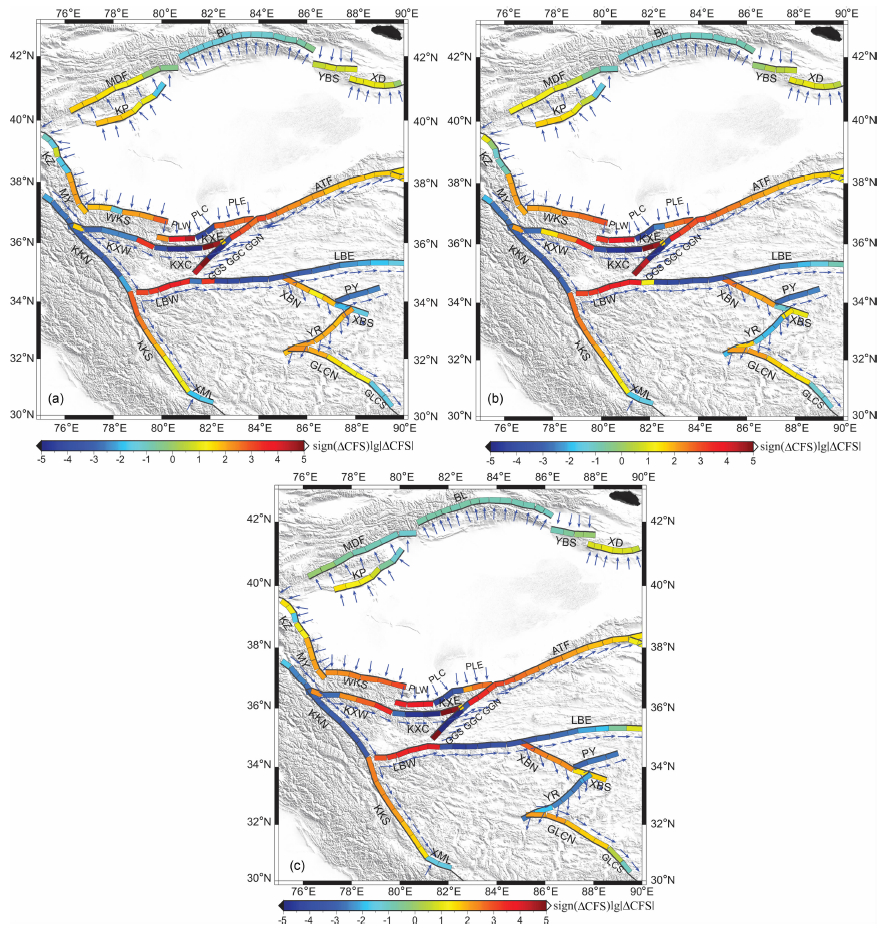
|
图 2 于田地震在周围活动断层8km深处的断层面和滑动方向上产生的库仑破裂应力变化.(a),(b),(c)假定视摩擦系数分别为0.0,0.4,0.8的库伦破裂应力变化.(a)也是投影到断层面上的剪切应力变化.其中蓝色表示库仑破裂应力下降绝对值的对数的负值.红色表示库仑破裂应力增加值的对数.断层特性用蓝箭头表示,指向断层的箭头表示为逆冲断层,远离断层的箭头表示拉张断层;与断层平行的箭头表示走滑断层上盘的运动方向.断层在地表的出露迹线用黑粗线表示.断层名的缩写列于表 1.应力变化的单位为Pa. Fig. 2 ACFS caused by Yutian earthquake and projected on fault plane and slip direction of the surrounding active faults at 8 km depth. (a), (b), and (c) are ACFS measured assuming apparent friction coefficient=0.0, 0.4, and 0.8, respectively. (a) is also the shear stress projected on fault plane and slip direction. Colors between blue and green stand for decrease, and between red and green for tncrease of ACFS, respectively. The colors are tn logarithmic scale of the absolute ACFS. Negative scale stands for decrease, and positive scale for tncrease of ACFS, respectively. Senses of fault slip directions are denoted by blue arrows: thrust and normal faults are ndicated by arrows pointing to and away from the patches, respectively; fault parallel components of the arrows mark the motion directions of the strike-slip components. Thick black lines on the rims of the fault patches denote the locations of fault traces. Abbreviations of fault names are listed in Table 1. The unt of the stress chang is Pa. |
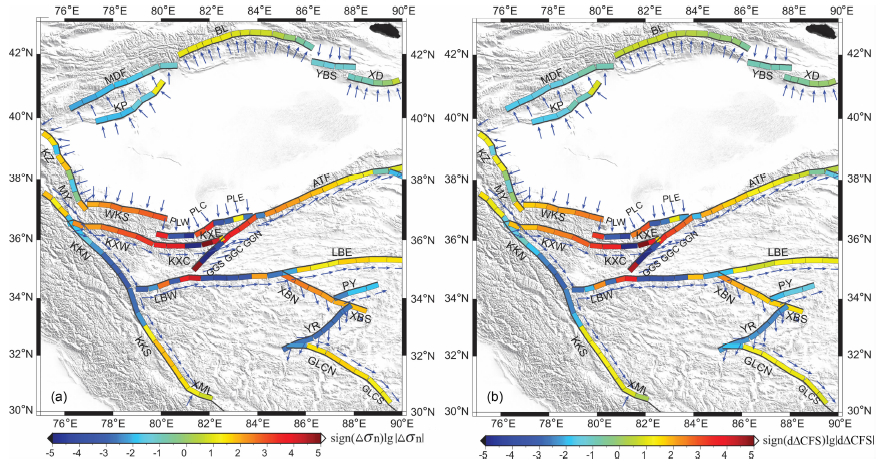
|
图 3 (a)于田地震产生的正应力变化;(b)视摩擦系数为0.4和0.0或0.8和0.4导致的库伦破裂应力变化的差别.所有结果计算均假定深度为8km.粗黑线表示断层迹线的位置.断层名的缩写列于表 1 Fig. 3 (a) Normal stress Δσn induced by Yutian earthquake; (b) ACFS differences on faults between the results calculated assuming apparent friction coefficients of 0.4 and 0.0 or 0.8 and 0.4. All the results are evaluated on fault planes at 8 km depth. Thick black lines on the rims of the fault patches denote the locations of fault traces. Abbreviations of fault names are listed in Table 1 |
我们进一步采用断层上的ΔCFS来估计其地震危险性变化.由于缺乏历史地震记录、现今构造加载水平和地震复发时间,精确估计地震危险性很困难.然而采用现今探测的构造信息,我们可以采用库伦破裂应力变化估计该断层段上下一个特征地震的提前或延迟时间.我们采用三个步骤进行估计:第一步,得到研究地区主要活动断层的长期滑动速率;第二步将长期滑动速率转化为断层上的应变积累率;我们假定断层之下16km闭锁,地表变形按D(x)=2S/πarctan(x/H)进行,这里S为地表滑动速率,x为平均深度,H为闭锁深度.地表的剪切应变速率为

我们考虑了于田地震在周边断裂产生的影响,但于田地震是否也受到本地区其他地震,如2005年Mw7.6巴基斯坦地震的触发呢?根据Avouac等[32]运用地震波资料反演的2005年巴基斯坦地震破裂分布,依照上面计算库仑破裂应力变化的方法,我们得到巴基斯坦地震在于田地震破裂面和滑动方向上的库仑破裂应力变化(图 4).由图可见,巴基斯坦地震造成于田地震断层面上的库仑破裂应力变化为10~20Pa.虽然该地震的发生有利于于田地震的发生,但该应力变化很小,远小于季节性气压变化的影响.研究该地震对于田地震发生的影响可能需要借助于动态应力触发的研究思路[33],这有待于做进一步的工作.
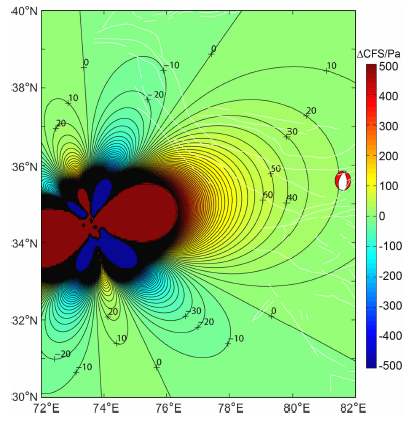
|
图 4 2005年巴基斯坦地震在于田地震破裂面和滑动方向上产生的库仑破裂应力变化.海滩球表示2008年3月21日于田地震.白色线段为中国境内的断层分布[16]. Fig. 4 The Coulomb failure stress change produced by the 2005 Pakistan earthquake and projected on the fault plane and slip direction of the Yutian earthquake. The beach ball indicates the Yutian earthquake occurred on March 21, 2007. White lines are the faults in Chinese mainland. |
发生地震区域的哈佛矩张量目录建立以来,发生在该地震周围的震源机制均为正断层机制,如何解释这些正断层机制地震,这个现象与该地区的断层运动有何关系?
于田地震发生区域由北部的康西瓦左旋走滑断裂、东南方向左旋兼正断的贡嘎错断裂、南部的龙木错-邦达错左旋走滑断裂西段和西南方向的右旋喀喇昆仑断裂所围限,并且该区域中自1976年以来发生了很多正断层机制的地震(图 1).正确理解这些正断层地震的形成对理解青藏高原西北部的形变模式和动力学有重要意义,对地震危险性分析也有重要的应用价值.
所围限区域西部跨喀喇昆仑断裂右旋走滑速率为1±3mm/a [30],表明兴都库什块体相对于青藏西北缘向西北方向运动.由于沿着阿尔金断裂的左旋走滑速率较大(东部远场,阿尔金断裂中段滑移达9mm/a[31]),而喀喇昆仑断裂右旋走滑的速率较小,且沿北北西方向,两个运动方向合成使得贡嘎错断裂呈现为左旋张扭的运动模式,与喀喇昆仑右旋走滑断裂模式形成对比,致使该地震震源区域呈现东西向拉张的应力状态.从更大尺度上来说这一区域应力状态应是印度板块向中亚地区北向楔入的结果.
6 讨论与结论我们根据于田地震的震源破裂参数计算了在周围断层上的库仑破裂应力变化.结果表明,该地震的发生使得康西瓦断裂西段东部和东段、贡嘎错断裂南段和北段、普鲁断裂西段和东段、西昆仑山前断裂、米牙断裂、阿尔金断裂、龙木错-邦达错西段、向阳湖-布若错北段、格林错北段、喀喇昆仑南段、柯坪断裂和迈丹断裂西段和兴地断裂加载,使得康西瓦断层和贡嘎错断层中段、普鲁断裂中段、琵琶湖-映天湖、格林错南段、北喜玛拉雅断裂、喀喇昆仑北段和北轮台断裂松弛.这些库仑破裂应力变化的量值虽然很小,但按照Ziv和Rubin[29]的研究,也会对地震活动性产生一定的影响,因此该结果对该地区的危险性分析具有一定的参考意义.
我们根据于田地震发生的地质背景和形变模式,分析了该地震及其周围地震出现正断层机制的原因,认为该区域的正断层机制是青藏高原沿阿尔金断裂的整体东向运动和兴都库什块体的北西向运动的相互作用导致了研究区域东西向拉张的形变模式.
2008年5月12日的汶川地震发生在青藏高原东缘和四川盆地西北缘,距于田地震震中约2136km,发震时间间隔52天.而于田地震在如此远距离的龙门山断裂上产生的库仑破裂应力变化几乎为零.要研究于田地震对汶川地震的影响,需要考虑动态应力触发[33]的影响.
本研究对周围断层活动影响的一级近似估算采用了比较简单的弹性半空间模型.实际上地球介质的三维不均匀结构对库仑破裂应力变化的计算结果有一定影响.另外,由于地球的黏弹性松弛效应,大地震后会产生应变的扩散[9, 10, 34, 35],这些效应也会对库仑破裂应力变化结果产生一些影响.然而,需要说明的是,黏弹性效应仅在应力作用时间与应力释放的特征时间近似或大于应力释放的特征时间时才变得比较重要.这样的特征时间对于麦克斯韦流变体可按τ=2η/μ计算.软流层黏度的典型值范围为1019~1021 Pa·s,这预示着剪切模量为3×1010 Pa的介质特征时间范围为109~1011 s,对应于30~3000年.黏弹性效应在描述发生时间间隔为几十年到几个世纪的邻近大地震之间的相互作用时是不可忽略的.对于发生在时间间隔较短的对地震发生影响的粗略估计中,这种效应是可以忽略不计的.
由大地震之后的大量余震发生会产生在地表可以观测到的地表位移场[36]可以推知,大量余震也会对周围断层产生一定的影响,但由于目前还没有可以利用的大量余震的震源破裂信息,本研究也未对其进行考虑.但根据美国南加州Landers地震余震产生的地表位移场的分析可知,余震产生的位移场与主震位移场方向基本一致[36],并且不足主震产生位移场的10%,由此可以推断余震产生的应力变化也大致为主震应力变化的10%左右.即使考虑了于田地震余震的影响也不会改变本研究结果的空间模式.
高孔隙压力流体的存在,可以成功地解释圣安德烈斯断层地热流量密度低和断层外围主压应力方向与断层成近乎垂直的高角度现象.巴巴多斯俯冲带的地震和钻探结果以及最近日本、新西兰地震层析成像和大地电磁的成果也都提供了高孔隙水压存在的观测证据[37](Zhao et al.,1996).因此地震产生的应力变化导致的流体在含水层中的迁移可能是在中等时间尺度(几天至几个月)上影响后续地震发生的因素之一[38~40].由于流体迁移参数的不确定性在本研究的计算中未针对不同情况加以考虑.
致谢审稿人提出的修改意见使本文得以很大改进,特此致谢!
| [1] | Harris R A. Introduction to special section:Stress triggers, stress shadows, and implications for seismic hazard. J Geophys Res , 1998, 103: 24347-24358. DOI:10.1029/98JB01576 |
| [2] | Stein R S. The role of stress transfer in earthquake occurrence. Nature , 1999, 402: 605-609. DOI:10.1038/45144 |
| [3] | 王仁, 孙苟英, 蔡永恩. 华北地区近700年地震序列的数学模拟. 中国科学(B辑) , 1982, 8: 745–753. Wang R, Sun X Y, Cai Y E. A mathematical simulation for nearly 700 years earthquake sequence in North China. Scientia Sinica (Series B) (in Chinese) , 1982, 8: 745-753. |
| [4] | Stein R S, Lisowski M. The 1979 Homestead Valley earthquake sequence, California:Control of aftershoeks and postseismic deformation. J Geophys Res , 1983, 88: 6477-6490. DOI:10.1029/JB088iB08p06477 |
| [5] | 万永革, 吴忠良, 周公威, 等. 几次复杂地震中不同破裂事件之间的"应力触发"问题. 地震学报 , 2000, 13(6): 607–615. Wan Y G, Wu Z L, Zhou G W, et al. "Stress triggering" between different rupture events in several earthquakes. Acta Seismologica Sinica (in Chinese) , 2000, 13(6): 607-615. DOI:10.1007/s11589-000-0062-3 |
| [6] | 万永革, 吴忠良, 周公威, 等. 地震静态应力触发模型的全球检验. 地震学报 , 2002, 15(5): 559–577. Wan Y G, Wu Z L, ZhouG W, et al. Research on seismic stress triggering. Acta Seismologica Sinica (in Chinese) , 2002, 15(5): 559-577. DOI:10.1007/s11589-002-0025-y |
| [7] | Wan Y G, Wu Z L, Zhou G W. Small stress change triggering a big earthquake:a test of the critical point hypothesis for earthquake. Chin Phys Lett , 2003, 20(9): 1452-1455. DOI:10.1088/0256-307X/20/9/312 |
| [8] | Wan Y G, Wu Z L, Zhou G W. Focal mechanism dependence of static stress triggering of earthquakes. Tectnophysics , 2004, 390: 235-243. DOI:10.1016/j.tecto.2004.03.028 |
| [9] | 沈正康, 万永革, 甘卫军, 等. 东昆仑活动断裂带大地震之间的黏弹性应力触发研究. 地球物理学报 , 2003, 46(6): 1125–1138. Shen Z K, Wan Y G, Gan W J, et al. Viscoelastic triggering between large earthquakes along the east Kunlun fault system. Chinese J.Geophys. (in Chinese) , 2003, 46(6): 1125-1138. |
| [10] | 沈正康, 万永革, 甘卫军, 等. 华北地区700年来地壳应力场演化与地震发生研究. 中国地震 , 2004, 20(3): 211–228. Shen g K, Wan Y G, Gan W J, et al. Crustal stress evolution of the last 700 years in north China and earthquake occurrence. Earthquake Research in China (in Chinese) , 2004, 20(3): 211-228. |
| [11] | Robinson R, Zhou S. Stress interactions within the Tangshan, China, earthquake sequence of 1976. Bull Seis Soc Amer , 2005, 95(6): 2501-2505. DOI:10.1785/0120050091 |
| [12] | Lienkaemper J J, Galehouse J S, Simpson R W. Long-term monitoring of creep rate along the hayward fault and evidence for a lasting creep response to 1989 Loma Prieta earthquake. Geophys Res Lett , 2001, 28(11): 2265-2268. DOI:10.1029/2000GL012776 |
| [13] | McCloskey J, Nalbant S S, Steacy S. Earthquake risk from co-seismic stress. Nature , 2005, 434: 291. DOI:10.1038/434291a |
| [14] | Parsons T, Ji C, Kirby E. Stress changes from the 2008 Wenchuan earthquake and increased hazard in the Sichuan basin. Nature , 2008. DOI:10.1038/nature07177 |
| [15] | 万永革, 沈正康, 盛书中, 等. 2008年汶川大地震对周围断层的影响. 地震学报 , 2009, 31(2): 128–139. Wan Y G, Shen Z K, Sheng S Z, et al. The influence of 2008 Wenchuan earthquake on surrounding faults. Acta Seismologica Sinica (in Chinese) , 2009, 31(2): 128-139. |
| [16] | 邓起东, 张培震, 冉勇康, 等. 中国活动构造基本特征. 中国科学(D辑) , 2003, 46(4): 356–372. Deng Q D, Zhang P Z, Ran Y K, et al. Basic characteristics of active tectonics of China. Science in China (Series D) (in Chinese) , 2003, 46(4): 356-372. |
| [17] | Chinnery M A. The stress changes that accompany strike-slip faulting. Bull Seism Soc Amer , 1963, 53: 921-932. |
| [18] | 陈运泰, 林邦慧, 林中洋, 等. 根据地面形变的观测研究1966年邢台地震的震源过程. 地球物理学报 , 1975, 18(3): 164–182. Chen Y T, Lin B H, Lin Z Y, et al. The focal mechanism of the 1966 HSINGTAI earthquake as inferred from the ground deformation observations. Chinese J.Geoph ys. (in Chinese) , 1975, 18(3): 164-182. |
| [19] | Okada Y. Internal deformation due to shear and tensile faults in a half-space. BullSeism Soc Amer , 1992, 82: 1018-1040. |
| [20] | Stein R S, King G C P, Lin J. Change in failure stress on the southern San Andreas fault system caused by the 1992 magnitude=7.4 Landers earthquake. Science , 1992, 258: 1328-1332. |
| [21] | King G C P, Stein R S, Lin J. Static stress changes and the triggering of earthquakes. Bull Seism Sac Amer , 1994, 84: 935-953. |
| [22] | Rice J R.Fault stress states, pore pressure distribution, and the weakness of the San Andreas fault.In:Evans B, Wong T F eds.Fault Mechanics and Transport Properties of Rock.Academic Press, London, 1992.475-503 |
| [23] | Peltzer G, Crampe F, King P. Evidence of nonlinear elasticity of the crust from the MW7.6 Mani (Tibet) earthquake. Science , 1999, 286: 272-276. DOI:10.1126/science.286.5438.272 |
| [24] | Lasserre C, Peltzer G, Crampae F, et al. Coseismic deformation of the MW=7.8 Kokoxili earthquake in Tibet, measured by synthetic aperature radar interferometry. J.Geophys.Res. , 2005, 110: B12408. DOI:10.1029/2004JB003500 |
| [25] | 万永革, 王敏, 沈正康, 等. 利用GPS和水准测量资料反演2001年昆仑山口西8.1级地震的同震滑动分布. 地震地质 , 2004, 26(3): 393–404. Wan Y G, Wang M, Shen Z K, et al. Co-seismic slip distribution of the 2001 west of Kunlun mountain pass earthquake inverted by GPS and leveling data. Seismology and Geology (in Chinese) , 2004, 26(3): 393-404. |
| [26] | 万永革, 沈正康, 王敏, 等. 根据GPS和InSAR数据反演2001年昆仑山口西地震同震破裂分布. 地球物理学报 , 2008, 51(4): 753–764. Wan Y G, Shen Z K, Wang M, et al. Coseismic slip distribution of the 2001 Kunlun mountain Pass west earthquake constrained using GPS and InSAR data. Chinese J.Geophysics. (in Chinese) , 2008, 51(4): 753-764. |
| [27] | Wells D L, Coppersmith K J. New empirical relationships among magnitude, rupture area and surface displacement. Bull.Seism.Soc.Amer. , 1994, 84: 974-1002. |
| [28] | 沈正康, 王敏, 甘卫军, 张祖胜. 中国磊大陆现今构造应变率场及其动力学成因研究. 地学前缘 , 2003, 10(Suppl.): 93–100. Shen Z K, Wang M, Gan W J, Zhang Z S. Contemporary tectonic strain rate field of Chinese continent and itsgeodynamics implication. Earth Science Frontiers (in Chinese) , 2003, 10(Suppl.): 93-100. |
| [29] | Ziv A, Rubin A M. Static stress transfer and earthquake triggering:No lower threshold in sight?. J Geophys Res , 2000, 105: 13631-13642. DOI:10.1029/2000JB900081 |
| [30] | Wright T J, Parsons B, England P C, Fielding E J. InSAR observations of low slip rates on the major faults of western Tibet. Science , 2004, 305: 236-239. DOI:10.1126/science.1096388 |
| [31] | Shen Z K, Wang M, Li Y, et al. Crustal deformation associated with the Ahyn Tagh fault system, western China, from GPS. J Geophys Res , 2001, 106: 30607-30621. DOI:10.1029/2001JB000349 |
| [32] | Avouae J P, Ayoub F, Leprinee S, et al. The 2005, Mw7.6 Kashmir earthquake:sub-pixel correlation of ASTER images and seismic waveforms analysis.. Earth and Planetary Science Letters , 2006, 249(3-4): 514-528. |
| [33] | Kilb D, Gomberg J, Bodin P. Earthquake triggering by dynamic stresses. Nature , 2000, 408: 570-574. DOI:10.1038/35046046 |
| [34] | Deng J, Gurnis M, Kanamori H, Hauksson E. Viscoelastic flow in the lower crust after the 1992 Landers, California, earthquake. Science , 1998, 282: 1689-1692. DOI:10.1126/science.282.5394.1689 |
| [35] | 万永革, 沈正康, 曾跃华, 等. 青藏高原东北部的库仑应力积累演化对大地震发生的影响. 地震学报 , 2007, 20(2): 117–132. Wan Y G, Shen Z K, Zeng Y H, et al. Evolution of cumulative Coulomb failure stress in northeastern Qinghai-Xizang (Tibetan) Plateau and its effect on large earthquake occurrence. Acta Seismologica Sinica (in Chinese) , 2007, 20(2): 117-132. DOI:10.1007/s11589-007-0117-9 |
| [36] | 万永革, 沈正康, 兰从欣. 兰德斯地震断层面及其附近余震产生的位移场研究. 地震学报 , 2005, 18(2): 147–153. Wan Y G, Shen Z K, Lan C X. Study on displacement field generated by aftershocks in Landers earthquake fault zone and its adjacent areas. Acta Seismologica Sinica (in Chinese) , 2005, 18(2): 147-153. DOI:10.1007/s11589-005-0061-5 |
| [37] | Zhao D, Kanamori H, Negishi H, et al. Tomography of the source area of the 1995 Kobe earthquake:Evidence for fluids at the hypocenter. Science , 1996, 274: 1891-1894. DOI:10.1126/science.274.5294.1891 |
| [38] | Hudnut K W, Seeber L, Pacheco J. Cross-fauh triggering in the November 1987 Superstition Hills earthquake sequence, southern California. Geophys Res Lett , 1989, 16: 199-202. DOI:10.1029/GL016i002p00199 |
| [39] | Noir J, Jacques E, Bukri S, et al. Fluid flow triggered migration of events in the 1989 Dobi earthquake sequence of central Afar. Geophys Res Lett , 1997, 24: 2335-2338. DOI:10.1029/97GL02182 |
| [40] | 万永革, 沈正康, 曾跃华, 等. 唐山地震序列应力触发的粘弹性力学模型研究. 地震学报 , 2008, 21(6): 585–597. Wan Y G, Shen Z K, Zeng Y H, et al. Study on visco-elastic stress triggering model of Tangshan earthquake sequence. Acta Seismologica Sinica (in Chinese) , 2008, 21(6): 585-597. DOI:10.1007/s11589-008-0585-6 |
 2010, Vol. 53
2010, Vol. 53


